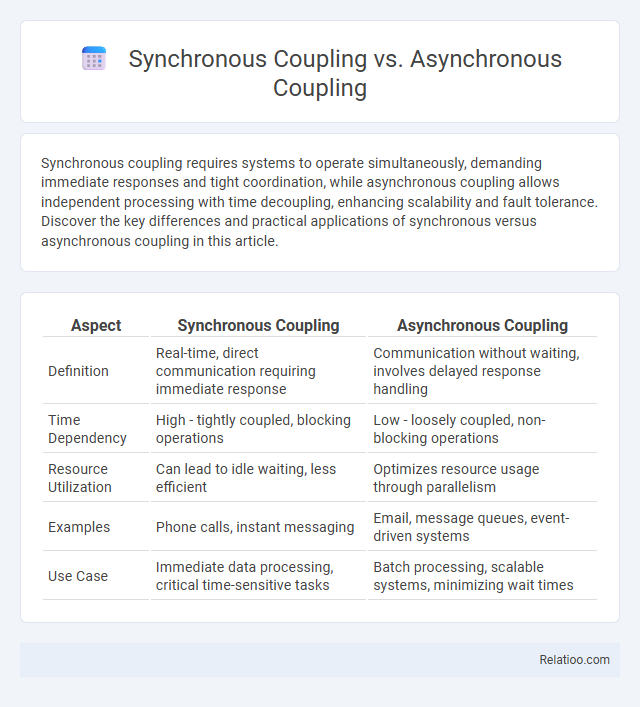Synchronous coupling requires systems to operate simultaneously, demanding immediate responses and tight coordination, while asynchronous coupling allows independent processing with time decoupling, enhancing scalability and fault tolerance. Discover the key differences and practical applications of synchronous versus asynchronous coupling in this article.
Table of Comparison
| Aspect | Synchronous Coupling | Asynchronous Coupling |
|---|---|---|
| Definition | Real-time, direct communication requiring immediate response | Communication without waiting, involves delayed response handling |
| Time Dependency | High - tightly coupled, blocking operations | Low - loosely coupled, non-blocking operations |
| Resource Utilization | Can lead to idle waiting, less efficient | Optimizes resource usage through parallelism |
| Examples | Phone calls, instant messaging | Email, message queues, event-driven systems |
| Use Case | Immediate data processing, critical time-sensitive tasks | Batch processing, scalable systems, minimizing wait times |
Introduction to Synchronous and Asynchronous Coupling
Synchronous coupling involves components interacting in a tightly coordinated manner, where one component waits for a response from another before proceeding, ensuring real-time communication and immediate data exchange. Asynchronous coupling allows components to communicate without waiting for immediate responses, enabling more flexible, decoupled interactions through message queues or event-driven architectures. Understanding these coupling mechanisms is essential for designing scalable, efficient software systems with appropriate dependencies and timing constraints.
Defining Synchronous Coupling
Synchronous coupling occurs when components or services depend on each other's availability and must wait for a response before proceeding. This tight integration contrasts with asynchronous coupling, where components interact without waiting, enabling more flexibility and scalability in system design. Understanding the differences helps you optimize system performance and reduce dependencies.
Defining Asynchronous Coupling
Synchronous coupling occurs when components depend on each other's availability, requiring real-time communication to complete processes, while asynchronous coupling allows components to interact without waiting for immediate responses, enhancing system scalability and resilience. Asynchronous coupling is defined by its ability to decouple sender and receiver processes, using messaging or event-driven architectures to enable independent operation and reduce system bottlenecks. Your software design benefits from asynchronous coupling by improving fault tolerance and enabling more flexible, modular interactions compared to tightly coupled synchronous systems.
Key Differences Between Synchronous and Asynchronous Coupling
Synchronous coupling requires components to interact in a tightly coordinated manner, where the caller waits for the callee to complete processing before proceeding, leading to higher dependency and potential bottlenecks. Asynchronous coupling allows components to communicate without waiting for immediate responses, enabling parallelism and decoupling that enhances system scalability and fault tolerance. The key difference lies in timing: synchronous coupling enforces blocking communication, whereas asynchronous coupling promotes non-blocking interactions, significantly impacting system performance and design flexibility.
Advantages of Synchronous Coupling
Synchronous coupling enables real-time communication between components, ensuring immediate data consistency and tighter integration, which improves system reliability and performance. It simplifies error handling by providing instant feedback and easier debugging during execution. This coupling type is ideal for scenarios requiring coordinated workflows and predictable timing, enhancing overall application responsiveness.
Advantages of Asynchronous Coupling
Asynchronous coupling allows systems to communicate without waiting for each other's response, improving scalability and fault tolerance by enabling independent processing. Your applications benefit from reduced latency and increased flexibility, as asynchronous methods decouple sender and receiver processes. This approach enhances overall system resilience and supports real-time data exchange in distributed architectures.
Drawbacks of Synchronous Coupling
Synchronous coupling tightly binds components by requiring simultaneous communication, which leads to increased latency and reduced system flexibility. This tight dependency often causes bottlenecks and higher risk of failure propagation, as one component must wait for the response of another before proceeding. In contrast, asynchronous coupling mitigates these drawbacks by allowing independent component execution, improving scalability and fault tolerance.
Drawbacks of Asynchronous Coupling
Asynchronous coupling reduces the need for components to wait on each other, improving system resilience and scalability but can introduce complexities such as increased latency, difficulty in error handling, and challenges in maintaining data consistency. Unlike synchronous coupling, where components communicate directly and immediately, asynchronous systems require careful design to handle message queues and retries, which can complicate debugging and monitoring. Your system may face challenges in ensuring reliable communication and managing eventual consistency when relying heavily on asynchronous coupling.
Use Case Scenarios: When to Choose Each Coupling Style
Synchronous coupling suits real-time systems where immediate response is critical, such as payment processing or online gaming, ensuring components communicate with direct dependencies. Asynchronous coupling excels in event-driven architectures and microservices, ideal for handling high-throughput workflows like order processing or user notifications without waiting for immediate responses. Loose coupling overall improves system flexibility and scalability, making it essential for distributed systems that require modular, decoupled components to evolve independently.
Best Practices for Coupling in Modern System Design
Synchronous coupling requires components to interact in real-time, often leading to tight dependencies and reduced system flexibility. Asynchronous coupling decouples components by enabling communication through message queues or events, enhancing scalability and fault tolerance in distributed systems. Your modern system design should prioritize asynchronous coupling to improve resilience, maintainability, and scalability while minimizing the risks of bottlenecks and tightly coupled failures.

Infographic: Synchronous Coupling vs Asynchronous Coupling
 relatioo.com
relatioo.com